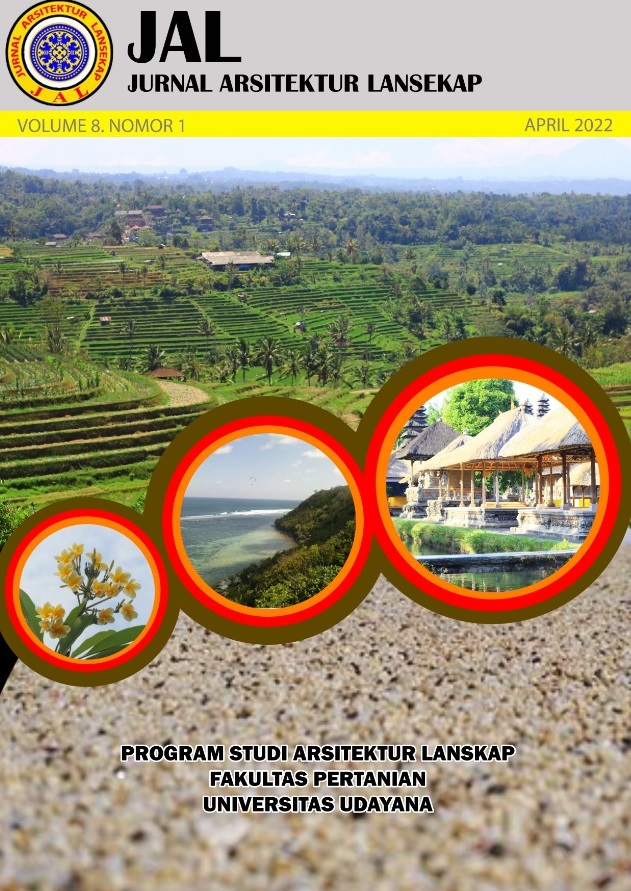Persepsi dan Preferensi Kenyamanan Taman Monumen Perjuangan Kapten TNI Anak Agung Gede Anom Mudita
Abstract
Convenience perceptions and preferences Taman Monumen Perjuangan Kapten TNI Anak Agung Gede Anom Mudita. Taman Monumen Perjuangan Kapten TNI Anak Agung Gede Anom Mudita has a strategic location right in the center of the city. The interest and awareness of peoples around to utilization Taman Monumen Perjuangan Kapten TNI Anak Agung Gede Anom Mudita as a public space or public area are quite high. However, the comfort value of this public space is still less, there are no facilities like restroom, benches, gazebos and several elements have been broken like statues, lights, paths as far as plants found at some area with faded condition. Those problems becomes idea and also a goal to find out how visitors perceptions and preferences about Taman Monumen Perjuangan Kapten TNI Anak Agung Gede Anom Mudita. This research used a survey as a method with data collection techniques through observation, interviews, questionnaires, and literature study. The results collected about 55.8% of visitors said enough which was seen from nine indicators including circulation, shelter, noise, smells, shape, security, cleanness, beauty, and facilities with diverse preferences. The suggestion that can be given that the government and the management need to improve maintenance, cleanness and adding more facilities with a good arrangement so Taman Perjuangan Kapten TNI Anak Agung Gede Anom Mudita as a public space or public area can function properly.
Downloads
References
Hakim, R. (1993). Unsur–Unsur Perancangan Dalam Arsitektur, Bumi Aksara. Jakarta.
Hakim, R., & Utomo, H. (2008). Komponen Perancangan Arsitektur Lansekap: prinsip-unsur dan aplikasi desain. PT Bumi Aksara.
Jannah, M., Mugnisjah, W. Q., & Gunawan, A. (2015). Kajian Konsep Taman Islam Berdasarkan Al Quran dan Hadits. EL HARAKAH Jurnal Budaya Islam, 17(1), 1–17.
Laurie, M. (1986). Dasar-dasar Pertamanan. Departement of Landscape Architecture. University of California. Intermata.
Mongkaren, S. (2013). Fasilitas dan Kualitas Pelayanan Pengaruhnya Terhadap Kepuasan Penguna Jasa Rumah Sakit Advent Manado. Jurnal EMBA: Jurnal Riset Ekonomi, Manajemen, Bisnis Dan Akuntansi, 1(4).
Nazir. (2005). Metode Penelitian. Ghalia Indonesia.
Nyoman, W. (2010). Bentuk Seni Lukis Prasi I. Artikel Bulan September 2010, 9, 1–7.
Priyanti, D. (2012). Analisis perilaku permintaan rumah tangga dan jumlah pasokan cabai merah keriting di DKI Jakarta. Skripsi. Institut Pertanian Bogor. Bogor.
Rhesyana, B. R. (2014). Persepsi Pengunjung Taman Terhadap Tingkat Kenyamanan Taman-Taman di Kota Banjarnegara sebagai Ruang Publik. Scaffolding, 3(Persepsi Pengunjung Terhadap Tingkat Kenyamanan Taman), 9–14. http://journal.unnes.ac.id/sju/index.php/scaffolding
Sugiyono, P. (2011). Metodologi penelitian kuantitatif kualitatif dan R&D. Alpabeta, Bandung.
Suharto. (1994). Dasar-dasar Pertamanan. Media Wiyata.
Tae, M. A. K., Djoko, R., & Nailufar, B. (2019). Evaluasi Taman Kota Sebagai Taman Kota Layak Anak (Studi Kasus: Taman Singha Merjosari, Kota Malang). Fakultas Pertanian, 7(1).

This work is licensed under a Creative Commons Attribution-ShareAlike 4.0 International License.
An author who publishes in the Jurnal Arsitektur Lansekap (JAL) agrees to the following terms:
- Author retains the copyright and grants the journal the right of first publication of the work simultaneously licensed under the Creative Commons Attribution-ShareAlike 4.0 License that allows others to share the work with an acknowledgement of the work's authorship and initial publication in this journal
- Author is able to enter into separate, additional contractual arrangements for the non-exclusive distribution of the journal's published version of the work (e.g., post it to an institutional repository or publish it in a book) with the acknowledgement of its initial publication in this journal.
- Author is permitted and encouraged to post his/her work online (e.g., in institutional repositories or on their website) prior to and during the submission process, as it can lead to productive exchanges, as well as earlier and greater citation of the published work (See The Effect of Open Access).
Read more about the Creative Commons Attribution-ShareAlike 4.0 Licence here: https://creativecommons.org/licenses/by-sa/4.0/.







